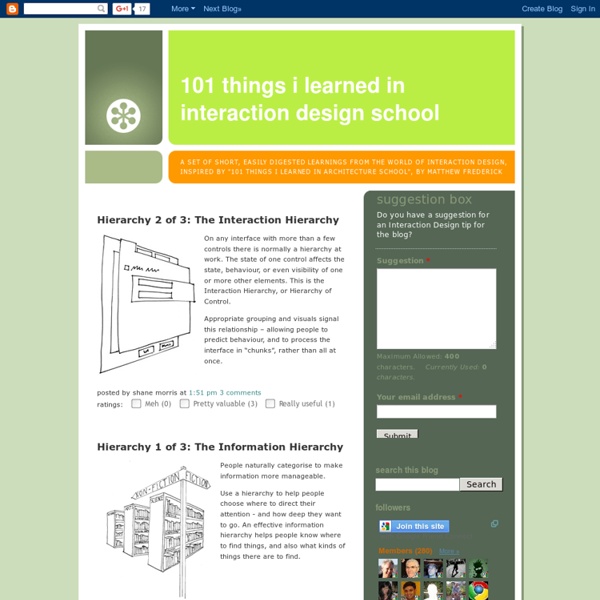



52 Weeks of UX The user experience is made up of all the interactions a person has with your brand, company, or organization. This may include interactions with your software, your web site, your call center, an advertisement, with a sticker on someone else’s computer, with a mobile application, with your Twitter account, with you over email, maybe even face-to-face. The sum total of these interactions over time is the user experience. The interaction designer plans for these moments. Part of their responsibility is to make all interactions positive, and includes aspects of the software, the copy-writing, the graphics, layout, flows, physical experiences. It’s a shame when one part of the experience is top notch and another is dreadful. User experience spans multiple practices. Web designers, traditionally secure in the role of page creators, now have a wider purview.
TagsCloud - Browse your tags precisely About TagsCloud TagsCloud is an interactive visualisation inspired from del.icio.us own tags cloud. It will enable you to have an overview of all your tags, and interactively determine the relations between them. What is special is that you can filter and re-arrange tags according to the number of posts that were tagged, and according to their connexion to the selected tags. TagsCloud is intended to be a tool for precisely selecting certain tags depending on your search criteria. Using TagsCloud TagsCloud represents all your tags at once, sorted by alphabetical order. By moving the cursor on the tag cloud, you will see the tag under your cursor as focused (represented in green), and related tags will turn blue and appear bigger. You can select tags by clicking on them, and as with SpaceNav, a red label will appear in the status bar (at the bottom of the screen). When one or more tags are selected you can hide non-related tags by clicking on the "HIDE RELATED" button in the status ba.
Ideation + Design | Writings on Digital Product Strategy & Design User laziness = user smartness, and why this is really important. A blog by Harry Brignull, User Experience Designer & Consultant — A blog by Harry Brignull, User Experience Designer & Consultant Note: This post might be a little dated. It was published in November 2008. User research is a funny thing. When you see users rushing through your user interface without stopping to think, or skipping through huge swathes of your lovingly prepared copy, it’s tempting to think of them as lazy sods. It’s true. It’s not negative. To quote Philip Johnson Laird (one of my favourite cognitive scientists): A calculator blindly follows the rules for multiplication or addition. The concept of productive laziness forms a valuable underpinning for our understanding of theories like information foraging, information scent, scan reading, and generally of user behaviour online. To put it simply: we are in the business of enabling users to be productively lazy in new and useful ways.
Search 4.0: Social Search Engines & Putting Humans Back In Searc Previously I’ve covered what I dubbed Search 3.0, how search engines have evolved toward blending vertical or specialized results into “regular” web listings. Today, the step beyond that: Search 4.0, how personal, social and human-edited data can be used to refine search results. The Search Evolution So Far Before going ahead, let me summarize what I covered in my past article, in terms of how search engines have changed over time to create and rank the results you get when doing a search: Search 1.0 (1996): Pages ranked using “on-the-page” criteriaSearch 2.0 (1998): Pages ranked using “off-the-page” criteriaSearch 3.0 (2007): Vertical search results blended into regular search results The evolution above is not perfect. As for Search 2.0, looking at off-the-page criteria such as links, Google kickstarted that heavily in 1998. To cap off the caveats, the evolution above is not the only way search engines can evolve. Search 4.0: The Human Factor Onward to Search 4.0! Enter humans.
Jacinthe Busson – Ergonomie web, mobile & logiciel Putting people first Big Data powers the modern world. What do we gain from Big Data? What do we lose? Al Jazeera America examines the role of technology and the implications of sharing personal information in the network’s first graphic novella, Terms of Service: Understanding Our Role in the World of Big Data. The new comic novella, available on Al Jazeera America’s website at is a thought provoking, entertaining field guide to help smart people understand how their personal, and often very private, data is collected and used. Co-produced by well-known cartoonist Josh Neufeld and Al Jazeera America reporter Michael Keller, Terms of Service is an entertaining feature that follows characters “Josh and Michael” as they journey through the challenges of digital privacy and other issues consumers should be aware of in the “brave new world” of technology and Big Data. Josh Neufeld is a nonfiction cartoonist living in Brooklyn.
The F**k It Way Experience Maps February 24th, 2010 An interesting depiction of user experience has surfaced the other week over at the nForm blog in the form of an experience map. Gene and his team has come up with a way to represent gaming related experiences of three distinct gamers. In a way then this is a merger between a persona and a time based representation. The other interesting thing about this is the visualization and separation of at least three types of experiences: ongoing, exploratory and influenced. Credits: Gene Smith of nForm
UX Storytellers